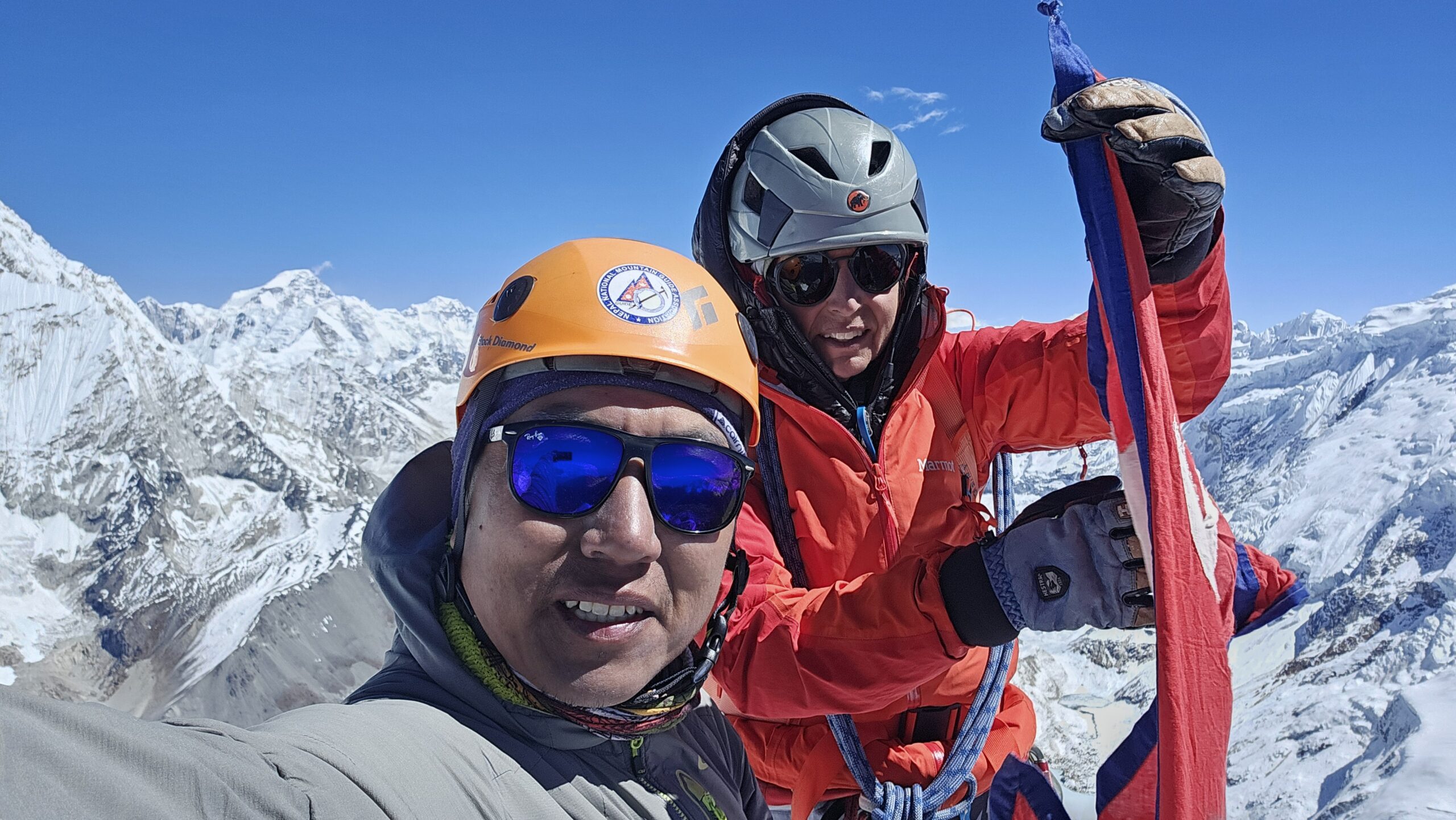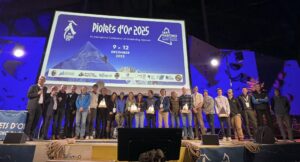Danika Gilbert of the U.S. and Pasang Kidar Sherpa of Nepal have climbed an aesthetic new route on 6,125m Beding Go in Rolwaling.
Pasang Kidar, an IFMGA guide and Managing Director of Khangri Trek based in Kathmandu, was climbing nearby Dolma Kang last year with Gilbert, when they saw the unclimbed northwest ridge of Beding Go (also spelled Bedding Go). The peak, part of the Gaurishankar massif, had had only one previous ascent, which was made by an international team up the south face in 2015.
“The good thing is that the climb starts virtually at the door of Pasang’s home,” Gilbert told ExplorersWeb.
From Beding village, the climbers trekked to the base of the mountain, aided by a porter who carried their gear to the 4,900m base camp. From there, they launched a single push, summiting on October 13.
Shared the permit
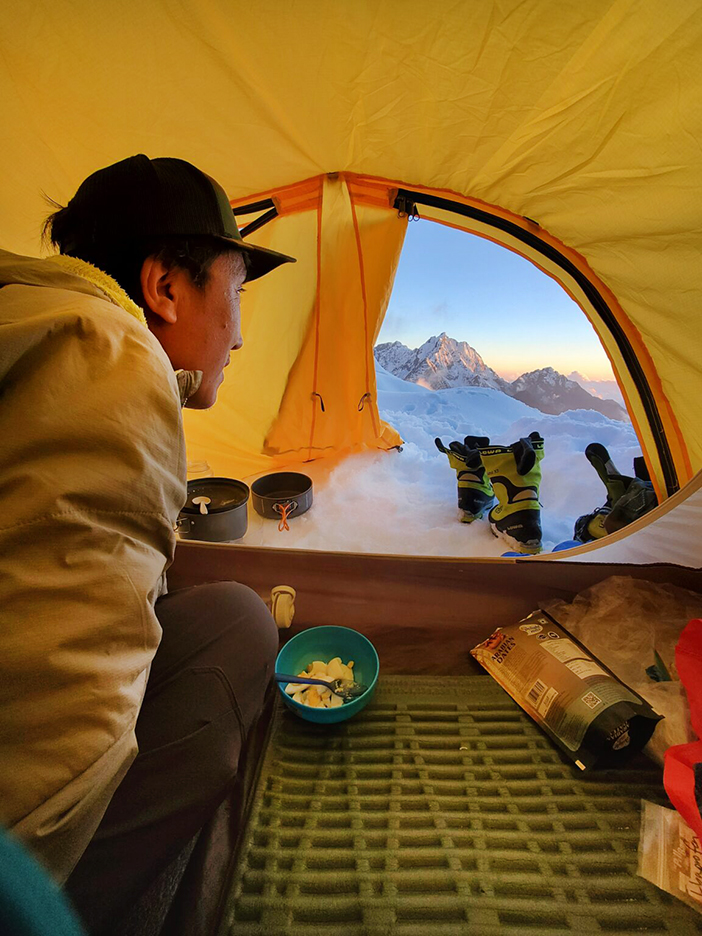
The view from high camp. Photo: Danika Gilbert
The pair minimized the cost of the climbing permit, which would have been quite pricey for Gilbert, by sharing it with a Japanese team. The Japanese group consisted of clients and several strong sherpas who had fixed ropes to a high camp at 5,100m. Pasang Kidar and Gilbert didn’t need the ropes but used the broken trail to 5,100m. From there, they launched their final push ahead of the Japanese.
The two followed a route through glaciated terrain to a ridge separating Tibet from Nepal.
“After 400m along this ridge and over several false summits, we reached the final 130m ridge traverse,” the climbers reported. “[There was] wild exposure on both sides: 1,350m down to the Rongshar Valley to the north and 700m back down to the Gaurishankar Khola Valley to the west.”
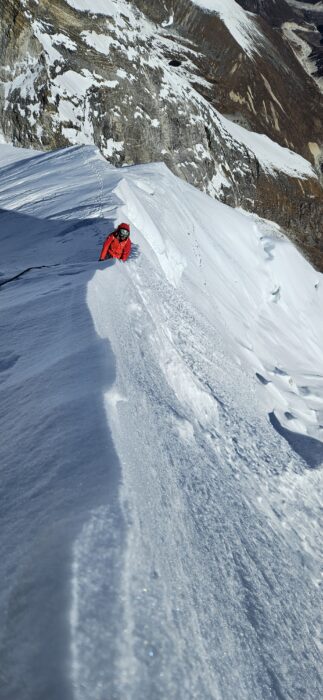
On the sharp summit ridge of Beding Go. Photo: Pasang Kidar
“We set off at 3:55 am, and reached the summit at 12:07 pm. It was much longer and more exposed than we had expected,” Gilbert admitted.
Pasang did most of the hard trail-breaking. Then on the long, sharp summit ridge, they faced several false summits and faceted snow. This prompted them choose their route carefully to minimize the high avalanche risk.
“There was no place to secure the route,” said Gilbert. “We progressed roped up and ready to each jump to opposite sides of the ridge if the snow gave way under our feet.”
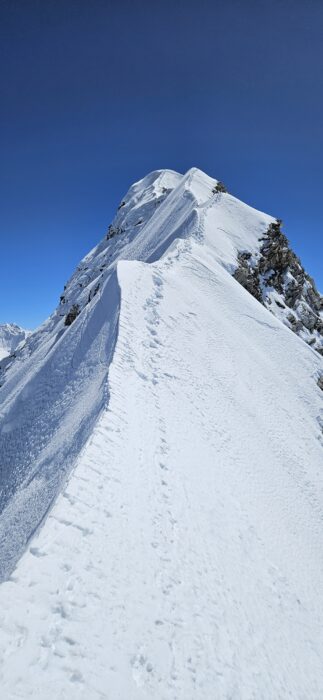
The ridge. Photo: Danika Gilbert
On the highest point, they found some rope belonging to the first summiters. They mostly retraced their steps on the way back. They named the line Friendship Ridge and rated it at Grade V, AI 3+, TD.
Possible with clients
Back in high camp, they described the ridge to the sherpas on the Japanese team.
“We told them it was very exposed, with no way to fix ropes properly, so we suggested they would need to go with two sherpa guides per client,” the climbers said.
The Japanese team tried the following day, but they soon retreated due to unstable snow conditions. Yet Pasang and Gilbert believe the route might be done with clients. Just not any client.
“In fact, this was one of the goals of the climb: to check if it would be a doable [commercial] route,” they said. “We think it is possible with a 1:1 guide-client ratio, as long as the [client] is a strong, experienced climber since there will be no fixed ropes from the high camp.”

The climbers on the ridge, as seen from base camp. Photo: Mingma Cherri
This is a promising trend for the future of climbing in Nepal. Beyond the fixed ropes on 8,000’ers, experienced guides and skilled clients have endless possibilities on technical routes on the country’s 6,000m peaks.
“It’s a purer, more sustainable way to do mountaineering in the Himalaya, and for me as a guide, it’s much more fun,” Gilbert said.
Pasang agreed. As they describe it, the route is slightly harder than Ama Dablam — and definitely lonelier. They compare it to the north face of Huandoy in Peru.
Joint project
Like Mingma G, Pasang Kidar Sherpa belongs to that generation of Rolwaling climbers pursuing personal climbing objectives in addition to their guiding. In 2017, he was part of the local team led by Nima Tenji Sherpa that bagged the first ascent of Langdung (6,326m).
Danika Gilbert is also a mountain guide based in Ridgway, Colorado, although she spends long periods in Nepal. The pair met climbing but joined forces to bring Afghan women and blind climbers to Nepal in order to expose them to trekking and climbing.
The goodwill project started in 2017 when they took a group of Afghan girls trekking in Langtang. When the Taliban took over, most of these girls fled Afghanistan and now live as refugees around the world.
“We are making an enormous effort to bring them from their foster countries, as they have serious difficulty obtaining traveling visas,” the climbers explained. “Luckily, the Nepalese government has been helpful, and some weeks ago, we managed to bring a group of them, currently living in Germany.”
The girls climbed Yalung Ri and another nearby peak with Pasand, Gilbert, Mingma Cherri Sherpa, and an American group.
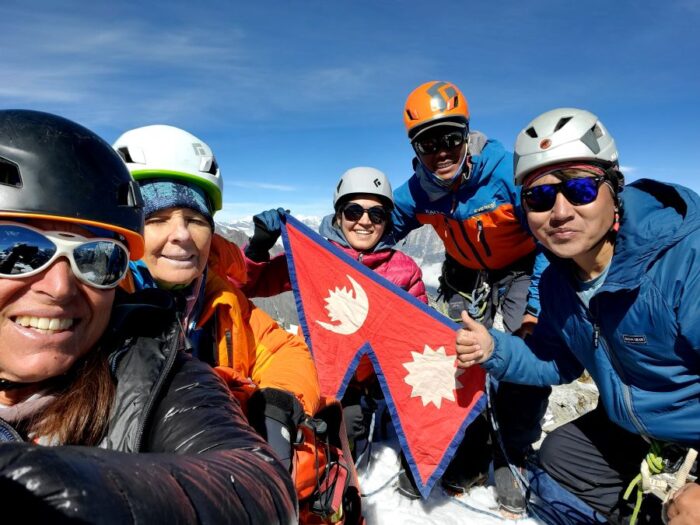
Summit photo earlier this fall. Photo: Mingma Cherri Sherpa
“By now, Nepal feels like home to them, and climbing mountains crosses frontiers and nationalities,” Gilbert explained. “It’s a place where they can be utterly happy and hide from their terrible reality. They feel exiled in a foreign land and cannot ever return to their home countries. In Nepal, they find themselves just mountaineers. And they have found great role models in female sherpa climbers such as Pasang Lamu Akita, Dawa Yangzum, and Maya Sherpa.”
